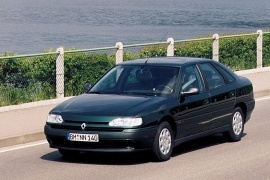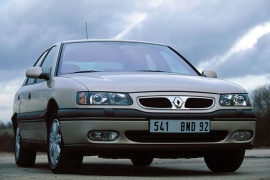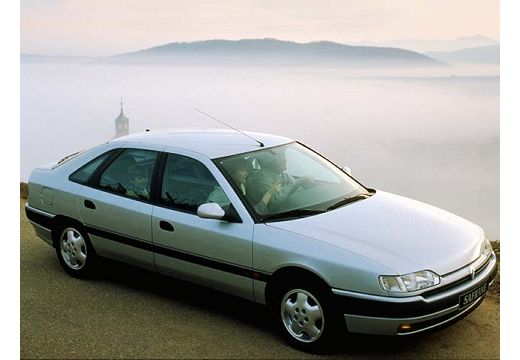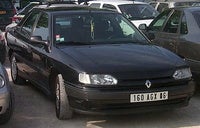Starting 2008, a new model, based directly on Renault Samsung SM5 sedan, is also called Renault Safrane.

1996 Renault Safrane

Renault Safrane (1996) - Front
The Safrane was launched in late 1992 to replace the ageing Renault 25 in the full-size market segment. Its clean, aerodynamic styling was quite conservative and very typical of early 1990s car design, also quite reminiscent of the 25's.

Renault Safrane (1996) - Rear
All Safranes were five-door liftbacks with transversely mounted engines. Front-wheel drive and four-wheel drive versions were available, with a range of petrol or diesel engines and manual or automatic transmissions. All petrol engines were fuel-injected and were fitted with three-way catalytic converters, as required in Europe after 1993 for engines of all sizes. The Safrane was also the first Renault to be equipped with air bags.

RENAULT Safrane 1992 - 1996
The Safrane carried over the Renault 25's five-door hatchback design that had gained wide customer acceptance in France. Despite the traditional preference for sedan bodies in the executive car segment, Renault decided to compete on the base of added practicality of the rear tailgate and split-folding rear seat (not available from most sedan-bodied competitors), as well as originality. Given the preference for German sedans from Audi, BMW and Mercedes-Benz of many executive car buyers, this can be viewed as good marketing tactics, allowing Renault to draw the buyers looking for alternatives, rather than compete head-on. The series 2 Safrane featured slightly (but visibly) different front ends in different versions, in an attempt to emphasize the unique status of more upmarket models, although these treatments differed in different markets.

Renault Safrane 1996

RENAULT Safrane 1996 - 2000
The Safrane's design was a deliberate effort to overcome the R25's main weaknesses — insufficient chassis stiffness and poor build quality. Renault was also keen to take noise reduction to best-in-class levels. These constraints resulted in a much heavier car than its predecessor (+200–300 kg / 440-660 lb.) due to a heavily reinforced chassis and the liberal use of sound-proofing materials.

Argus Renault safrane 2.0i

Renault Safrane a Wissembourg.

Renault Safrane (1996) - 1 of
The Safrane's launch was free of the build quality problems that ruined the Renault 25's reputation. Critics praised the car's comfortable and spacious interior, excellent noise insulation, and incisive handling. However, the manual transmission's cable-actuated shifter (a first on a Renault) drew heavy criticism for its rubbery, uncommunicative feeling that spoiled the driving experience — a significant issue in the European market where more than 80% of cars sold are manuals.

Photo 8 : SAFRANE - 1999

RENAULT Safrane II
Critics would also conclude that the car's acceleration and fuel economy was not up to the competition's standards, pointing out towards the engine's relative lack of power and torque compared to the vehicle's weight. As a result, sales outside France (where national preference guaranteed good results) remained limited, and the Safrane did not break the Germans' lock on the executive car market.

Renault Safrane

Renault Safrane (1996) - Front Angle

1996 Renault Safrane Overview

Renault Safrane 1996 1024x768

RENAULT Safrane 1996

1996 Renault Safrane

Renault Safrane (1996) - Front
The Safrane was launched in late 1992 to replace the ageing Renault 25 in the full-size market segment. Its clean, aerodynamic styling was quite conservative and very typical of early 1990s car design, also quite reminiscent of the 25's.

Renault Safrane (1996) - Rear
All Safranes were five-door liftbacks with transversely mounted engines. Front-wheel drive and four-wheel drive versions were available, with a range of petrol or diesel engines and manual or automatic transmissions. All petrol engines were fuel-injected and were fitted with three-way catalytic converters, as required in Europe after 1993 for engines of all sizes. The Safrane was also the first Renault to be equipped with air bags.

RENAULT Safrane 1992 - 1996
The Safrane carried over the Renault 25's five-door hatchback design that had gained wide customer acceptance in France. Despite the traditional preference for sedan bodies in the executive car segment, Renault decided to compete on the base of added practicality of the rear tailgate and split-folding rear seat (not available from most sedan-bodied competitors), as well as originality. Given the preference for German sedans from Audi, BMW and Mercedes-Benz of many executive car buyers, this can be viewed as good marketing tactics, allowing Renault to draw the buyers looking for alternatives, rather than compete head-on. The series 2 Safrane featured slightly (but visibly) different front ends in different versions, in an attempt to emphasize the unique status of more upmarket models, although these treatments differed in different markets.

Renault Safrane 1996

RENAULT Safrane 1996 - 2000
The Safrane's design was a deliberate effort to overcome the R25's main weaknesses — insufficient chassis stiffness and poor build quality. Renault was also keen to take noise reduction to best-in-class levels. These constraints resulted in a much heavier car than its predecessor (+200–300 kg / 440-660 lb.) due to a heavily reinforced chassis and the liberal use of sound-proofing materials.

Argus Renault safrane 2.0i

Renault Safrane a Wissembourg.

Renault Safrane (1996) - 1 of
The Safrane's launch was free of the build quality problems that ruined the Renault 25's reputation. Critics praised the car's comfortable and spacious interior, excellent noise insulation, and incisive handling. However, the manual transmission's cable-actuated shifter (a first on a Renault) drew heavy criticism for its rubbery, uncommunicative feeling that spoiled the driving experience — a significant issue in the European market where more than 80% of cars sold are manuals.

Photo 8 : SAFRANE - 1999

RENAULT Safrane II
Critics would also conclude that the car's acceleration and fuel economy was not up to the competition's standards, pointing out towards the engine's relative lack of power and torque compared to the vehicle's weight. As a result, sales outside France (where national preference guaranteed good results) remained limited, and the Safrane did not break the Germans' lock on the executive car market.

Renault Safrane

Renault Safrane (1996) - Front Angle

1996 Renault Safrane Overview

Renault Safrane 1996 1024x768

RENAULT Safrane 1996
No comments:
Post a Comment